In this article, I am going to share with you the top 15 SEO techniques for 2021 with helpful tips and tricks that will help you to boost your lead generation and organic traffic for your business.
According to 59% of B2B marketers say SEO has the biggest impact on their lead generation goals and using SEO for lead generation is extremely important.
Therefore, let me share with you the proven SEO techniques that will be very much important to effectively drive leads for your business and successfully compete with large brands.
So if you are preparing your B2B SEO strategy plan, then I recommend checking out these strategies I will be focusing on in 2022 to boost my website results.
1. Use Keyword Research Strategy
The first SEO technique that I must mention and is essential to your online success is keyword research as this SEO strategy is crucial for you to not only bring organic traffic but attract your B2B target audience that later can become leads.
And I know that keyword research is one of the top challenges in SEO and many make a lot of mistakes during keyword research. But it is essential to include keyword research within your B2B SEO strategy plan.
Keywords Research is basically an SEO technique to find topics, words, or phrases that people are using to find information and solutions and also your products and services.
It provides marketers with specific search data that can help them better understand their target audience and how they are using search engines to find information and solutions.
So, in reverse, marketers can use this data and information that they have got from keyword research and create pieces of content to target those SEO keywords and answer the questions of their target audience.
Therefore, the right keyword research is extremely important because you as a marketer get all the information you need for you to effectively form B2B SEO and B2B Content Marketing strategy plan.
Also, this helps Google as well, as thanks to keyword research your will be creating specific content for your industry which not only helps Google better understand and position your website, but it helps build the authoritativeness of your website which is one of the important ranking factors.
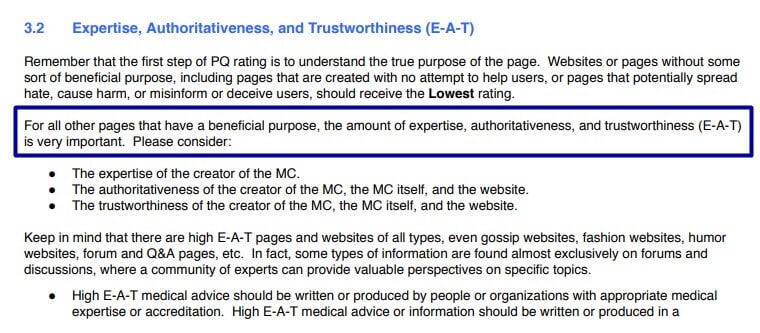
Therefore, whenever you start preparing a B2B SEO strategy plan you must conduct thorough keyword research as this will set your company website for success.
2. Optimize for On-Page SEO
The second on our list of SEO techniques is doing on-page SEO to ensure that your website maximizing the opportunities from your current effort.
I have seen so many bloggers and B2B marketers focusing on all kinds of marketing strategies to bring organic traffic and leads for their business but neglecting their on-page SEO strategy.
You must remember, that on-page SEO strategy is one of the biggest opportunities for you and one of the few marketing strategies that you have absolute control over, and by applying some of the best on-page SEO practices you can easily grow your organic traffic and lead generation.
So what is actually this strategy?
On-page SEO is the strategy to optimize your website pages and their elements in order to rank higher for targeted keywords in the search results.
And some of the on-page SEO techniques are:
- Page Speed
- Title tags
- Meta description
- Alt-text and picture name
- Keyword placement
And there are more on-page SEO techniques that you have absolute control over, and you should take control so you do not miss out on opportunities.
Because this strategy helps search engines and people to better understand what your web page is about by looking at things like title tag, URL path, and meta description.
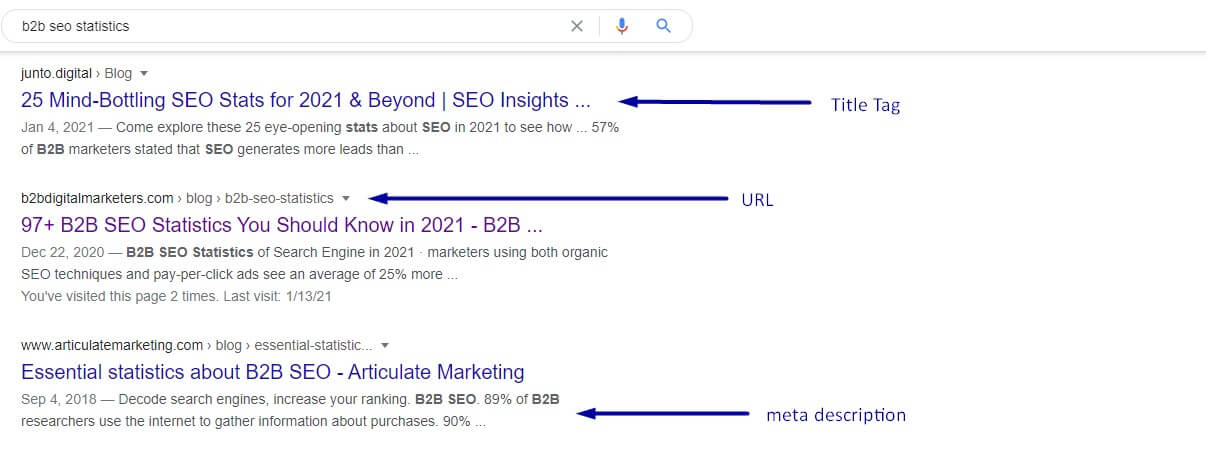
And it has been proven that just these three things properly SEO optimized tremendously boost your organic traffic, ranking, and lead generation.
But as I said, there is more to it and you should regularly do on-page SEO and SEO audit on your website to avoid SEO mistakes that harm you.
And to effectively audit your website I recommend using some of the top B2B SEO tools. These tools will help you to properly optimize your website without spending days on it.
3. Always plan for Off-Page SEO
The third from our list of SEO techniques is an Off-page SEO strategy that is another super important part of search engine optimization and driving more organic traffic and leads for your business.
So, let’s first discuss what is off-page SEO?
Off-page SEO is the practice of optimizing SEO outside of your own website in order to rank higher and earn more relevant traffic in search engines. Off-page optimization is focusing on ranking factors that involve improving search engines and user perception of a site’s popularity, relevance, trustworthiness, and authority.
On-page and Off-page SEO strategies are focusing on the same thing, but the way how you execute both digital marketing strategies is different, and generally speaking, off-page SEO techniques are more challenging than on-page SEO strategies.
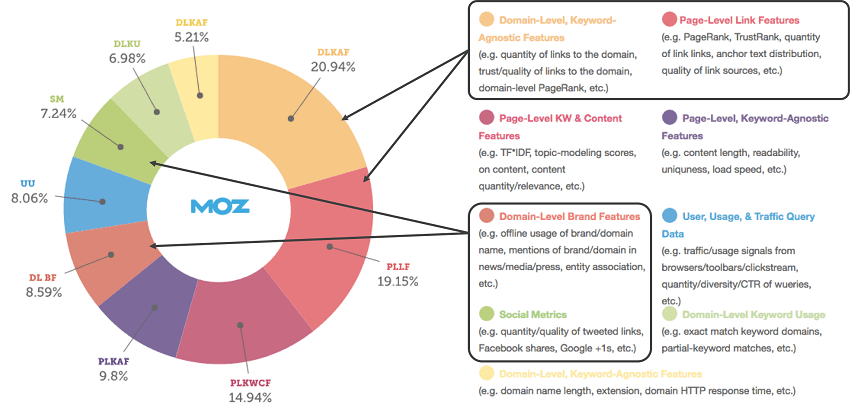
(source)
And while you can use some of the off-page services to help you with that I believe you would be better off hiring an SEO professional. You can also use some of the off-page tools such as SEMrush that is probably the most comprehensive or Ahrefs that is easy to use with powerful SEO features.
Either way, an off-page SEO strategy is super important because it helps you to increase your ranking, organic traffic, and lead generation by applying some of the best off-page practices. Just remember that it is quite challenging.
And according to the latest SEO trends, off-page techniques like link building, which is considered one of the hardest SEO strategies, is still very much important for your site to rank high in the search results. In fact, link building benefits are enourmous.
But there are more off-page seo activities:
- Building social shares
- Forum posting
- Brand mentions
- Blog directory submission
- Article directory submission
And as you can see most of those are link building techniques that are focusing on getting backlinks from other sites to increase PageRank.
4. Don’t sacrifice User Experience (UX)
The fourth SEO technique that you must be working on very hard and consistently is User Experience (UX) as this is becoming more important than ever with Google Core Web Vitals updates.
I remember those days when I could just stuff keywords on my website and start ranking for them, or if I wanted to go really hard, I put the keywords at the bottom of the page and make them the same color as my background to make them invisible to people but not to search engines.
These days are gone, and search engines are getting smarter and one of their main goals is to deliver a better user experience with every search they make. This means search engines like Google needs to update their algorithm frequently.
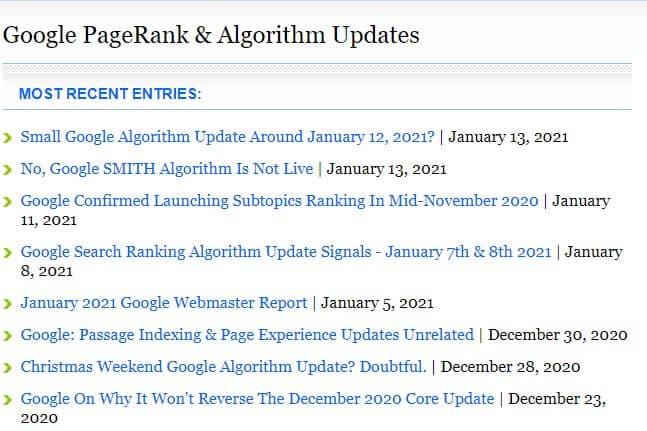
And not only them but webmasters must understand the user experience SEO factors and how UX impacts SEO to improve their ranking and conversion rates.
As recent studies from Forrester, Better UX could raise your website’s conversion rate by 200%, and better UX design could yield conversion rates of up to 400%.
So that means SEO + UX = success because a well-optimized website with SEO helps search engines, and search engines want to help users so they follow user experience metrics like:
- Click-through rate
- Bounce rate
- Time on website
- Visited pages per session
So UX and SEO strongly correlate and from looking at Google updates and some of the SEO trends and predictions I can see why is UX important to SEO.
And honestly, it makes sense, just a recent study from Walker Study shows that customer experience will overtake price and product as the key brand differentiator.
To summarize it why is UX important to SEO is because both are working together to help search engines and users to find relevant information as SEO helps search engines to give the right information and user experience provides the answer on the webpage.
5. Don’t Forget About Active Link Building
The next on our list of SEO Techniques I want to mention is Link Building. Link building strategy is still very much one of the top SEO Techniques that influence your ranking the most and it does not seem it will go away any time soon.
So what is it?
Link Building is a process of obtaining high-quality links from other websites to your own in order to increase the authoritativeness of the website and ranking in search results.
And there are many link building strategies to do that, but 65% of digital marketers state that link building is the hardest part of SEO as acquiring high-quality links from an authority website is not easy as it is very competitive and websites with high authority know the value of their backlink.
Thus they expect the same amount of value from those who are trying to acquire a link from them.
But the benefits of link building for your website are so great that you cannot simply ignore it and if you want to start generating organic traffic and leads, you must start applying some of the link building techniques.
Because as stated on Google, How Search Works in section Quality Content:
“if other prominent websites link to the page (what is known as PageRank), that has proven to be a good sign that the information is well trusted.”
But do not worry even though I said many digital marketers say link building is hard, there are quite a few types of link building strategies to start effectively build links to your site such as:
- Producing infographics
- Creating research posts
- Link Insertion
- Tiered Link Building
- Resource Link Building
- HARO Link Building
- Guest blogging
- Skyscraper technique
- Create unique and high-quality content (easily said than done)
Also, you can use some of the Link building services if you do not have the time or resources, but be sure that you must have the budget because these services aren’t cheap, and I would definitely avoid the cheap one.
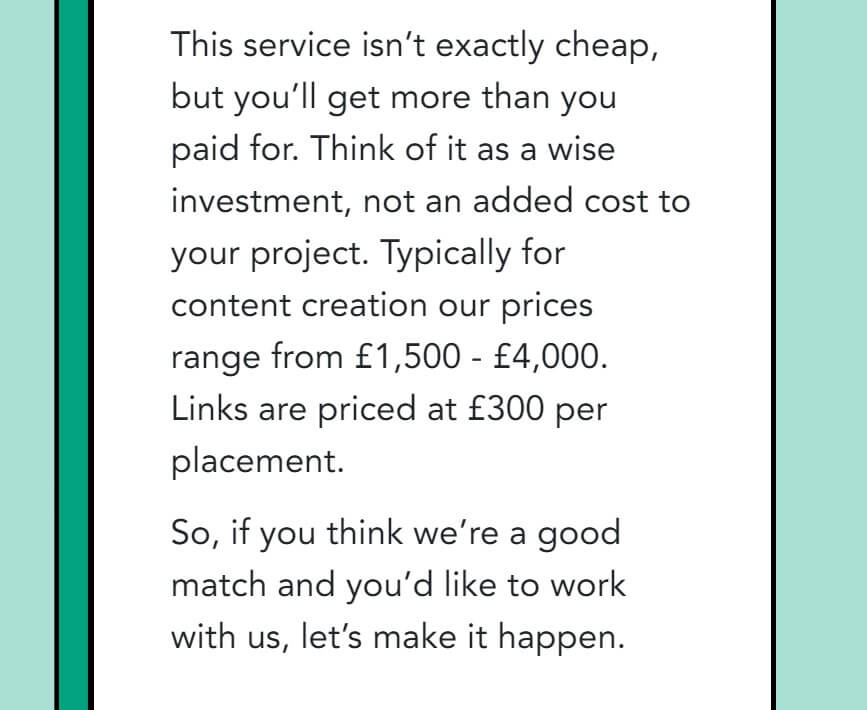
Also, you can use some of the link building tools like SEMrush or Ahrefs that will help you to find link building opportunities.
For example, SEMrush has link building features that help you to find prospects, connect with them, send an email, and even track the progress. This feature makes it easier to do link building,
Either way, if you use link building services or tools I also recommend you to follow some of the link building examples so you can learn them to do on your own.
6. Add Internal Linking Strategy (+Topic Clusters)
Another very important SEO technique that you should include within your SEO strategy plan is internal linking and topic clusters because using these two strategies is the way how you should structure your content to rank for more competitive keywords and of course boost your ranking.
But let’s first talk about internal link building.
Cross linking in SEO is one of the most important and easiest ways to increase your ranking for any of your web pages, but unfortunately, many bloggers and marketers are sometimes just too lazy to do that. Whether it is for their new blogs or pages or the older ones.
So what is internal linking and why do you need it?
Internal linking is connecting related pages on your website to each other by using links. Because both users and search engines are using links to discover new pages and find information. This gives you a certain power to show what pages are the most important on your website and thus boost its ranking. Typically, marketers using this strategy to boost their product or services pages in ranking.
I have mentioned linking mostly related pages to each other and I would like to a bit more explain what I mean by that and how Topic Clusters are related to that.

(source: hubspot.com)
I am not sure if you ever heard about the topic cluster, but I assume you did or if not, then you can use the provided link to learn more about it. Topic clusters are the new way how you should structure your content on your website, especially your blogs as this helps search engines and users find related content.
And by using topic clusters and internal linking you can boost your ranking and rank for more competitive keywords. These two strategies help Google to properly understand what your website is about and thus properly rank it.
Therefore, the recommended way to do SEO and start ranking for more competitive keywords is using topic clusters to build authority for your website.
And that is why link building and topics clusters are so important to boost lead generation and organic traffic and why you should start thinking about how to use these two strategies to boost your lead generation and organic traffic.
7. Spy on Your Competitors
Another SEO technique on the list I want to mention is to spy on your competitors to see what is working for them and then of course use it for yourself.
I understand that spying on your competitors is not the most honest among the types of SEO techniques out there. But this SEO technique is actually super important for your business whether you are a house marketer or marketing consultant.
Because I like to use this strategy especially when I am trying to understand my clients’ needs and find the low-hanging fruit, as by spying on competitors I can quickly discover opportunities that can bring new traffic and SEO leads for my client business.
But of course, there is a way how you should do that, and often I see that marketers who spy on competitors trying to compete with the competitor in the wrong way.
Let me give you an example. We have Competitors A, B, and C in a marketing niche. Each competitor is focusing on their own ways to generate organic traffic and lead to their business. From competitor analysis, I can see that Competitor A has a lot of organic traffic from keywords around email marketing, Competitor B from social media marketing, and Competitor C from SEO.
I can also see that Competitors A, B, and C have solid content-based and keyword backlinks on their high-performing topics. Therefore, this gives me an idea it would be tough to compete as they have high authority for those topics and keywords.
But from the competitor analysis, I have also discovered that each of them has content about digital marketing and it generates a pretty decent organic traffic despite they have only a few pieces of content and backlinks about digital marketing.
Also, I can see that quite a lot of organizations are bidding on this keyword, which means it could also be profitable.
Great you have found an opportunity that might be worth pursuing. Like this, you do not directly compete, which you would probably lose, but rather find untapped opportunities for your company and became the authority for your own topics.
And to spy on your competitors I recommend using tools like SEMrush, Ahrefs, SE Ranking, or Ubersuggest (Check out Ubersuggest alternatives) as with these tools you can find plenty of opportunities for your business and not only as these SEO tools help you to do much more, so check them out! Learn more about how SMO and SEO can work together.
https://youtu.be/dwjEz3GT98c
8. Put Some Effort to Your Keyword Title Tag
The next on our list of SEO techniques is your Title Tag that should include your Keyword and be catchy, so people want to click on it, and Search Engines better understand what is this blog post about.
Your Title Tag has much bigger power than you think and if you are not putting enough effort into your title tags you are probably losing out on organic traffic and wasting the hard work you have put into your blog articles.
The thing is that even if you are already ranking on the first page of Google, but your Title tag does not cut it, it will be quickly replaced if it does not get the clicks it is supposed to get.

Also according to Ahrefs, there is a correlation between including optimized SEO title tag and ranking. But we should take it with a pinch of salt as Google is smart and not necessarily needs to match exact keywords ever since Hummingbird was introduced.
So, your title tag does play role in your ranking. Therefore, you should put in some effort to optimize your title tag to be click-worthy, interesting, and reflect the topic you want to target.
Because Google made it clear a long time ago as they are searching for relevancy and your Title Tag shows Google and your audience how relevant is your blog article.
“ Our goal is simple: to give people the most relevant answers to their queries as quickly as possible. This requires constant tuning of our algorithms, as new content—both good and bad—comes online all the time. “
So, let’s look at some of the best practices for SEO Title Tag:
- Title tag lengths between 15 and 40 characters have an 8.6% higher CTR compared to those that are outside of that range. (Backlinko)
- Title tags that contain a question have a 14.1% higher CTR. (Backlinko)
- Keep your Title Tag around 50-60 Characters as Google will cut the rest.
- Optimize for one main “head” keyword
- Focus on Unique Part of Your Article
These are the best practices for Title tags, but of course, you can do more than just that, but remember sometimes is better to do less and properly than more but halfway.
9. Craft Your Meta Description
The next within SEO techniques is to craft your meta description with care and spend some time and effort on it.
Your meta description is like a good trailer, if you catch a user’s attention and provide something valuable and interesting to them, they will click.
And that is the whole point of the meta description as it works a as short teaser and opens a window for users to peek in and see what the article is about.
But a recent study shows from Digital Information World, that Google prefers using its own meta description based on ranking, searchers used keywords, and to match the website content.
As we can see on the graph, around 75% of the time Google does rewrite your meta description on the desktop searches.

And on mobile searches, we can see that it is slightly higher the rate, and for both, we can conclude that Google does change your meta description a lot.

But it does not mean you shouldn’t include your meta description as according to Backlinko, pages with a meta description have higher CTR vs without description. Thus, better ranking, and more organic traffic for you. Read more about CTR manipulation.
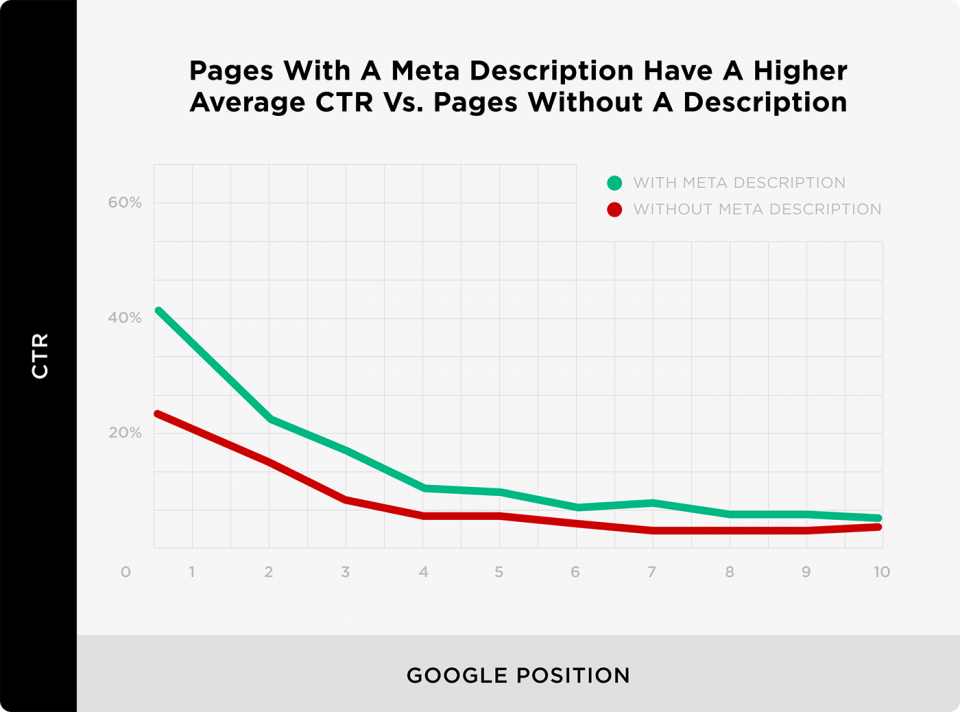
(Source)
So, whether Google does creates its own meta description for your pages or not, it is always better to include your meta description is it helps with your B2B SEO to rank better and for more relevant search terms.
And these are some of the best practices for meta description to improve your B2B SEO:
- Recommend descriptions between 50–160 characters.
- Create a compelling description that a searcher will want to click. (Need some copywriting skills)
- Avoid duplicate meta description tags. Even for some reason, the meta description is “perfect” for more of your pages, do not do that!
- Do not include double quotation marks. It does not work and Google can punish it with lower ranking or even removing the page from search.
- Do some A/B Testing. Do not write any meta description. I know I have shown data that on average it is better to have a meta description, but sometimes we need to test it and see on ourselves. So, don’t be scared to not write any.
So these are some of the best SEO meta description practices but feel free to Google more as there are plenty of good strategies.
10. Historical Optimization for B2B SEO Blog
The next on our list of SEO techniques is historical optimization for your blog posts.
I have only seen a very few blogs written about this, but it is definitely an important strategy that just not increases your organic traffic, but also brings more leads to your business.
The thing is that more and more content is written every day by companies, but demand is not growing anymore. That means the supply is going up while the demand is stagnating.
And according to WordPress, on their own platform users publish 70 million posts each month and Each month, approximately 409 million people view more than 20 billion pages.
On top of that, getting organic traffic to your new blog posts and pages can take a while and rank on the first page of Google even longer. According to Ahrefs‘ study, the average Top10 ranking page is 2+ years old. And those that rank at position #1 are almost 3 years old (on average).

But who is going to read a blog post that is 3 years old? Most people when they see a blog post from 3 years back will not go there as they believe it cannot be relevant and they can easily find an article written in recent months.
Or at least updated in recent months. I hope you see where it goes.
So to explain what is historical optimization, first I had to go through these data to explain why it is so important and now I can explain what it is.
Historical optimization of blog posts is taking old articles and add new information, update data and statistics if included, and generally refresh the article with new relevant ideas and information.
This is super important because most of the articles on Google have been seen at least 3 years back and yet they are still relevant to you and that is because it has been consistently updated to keep the information and the article up to date.
So, let’s look at some of the best historical optimization practices for B2B Blog you can apply right now to refresh your content, start getting traffic for your old blog posts again and keep bringing leads:
- Check top-performing blog posts year and two years ago and find relevant keywords that they have ranked for but are not included within the content.
- Focus on older than 12 months. If your website is new I recommend 18 months, as that is the average time when the website is getting some traction.
- Add new or replace CTA within blog posts with more relevant and up-to-date content to keep the conversion rate high.
- Update your publish date with a current new date when you republish the blog post.
- Promote the same way as you would do with a new article.
- Define your conversion path for updated content to fit your current goals and customer journey.
So, these are some of the best historical optimization practices for your content, definitely an important part of a B2B SEO strategy that you should include within your marketing mix. Just HubSpot itself has full-time people to just update their old blog posts to keep driving more organic traffic and leads for their business.

11. Shorten Your URL
The next on our list of SEO techniques to help you get a higher ranking and more organic traffic is using a shorter URL.
Google is using millions of ranking factors to determine where to position your blog posts between others and of course, some are less of the ranking factor than others, but still paying attention to SEO details is essential to get you in the top 10 in Google.
And usually often overlooked by many marketers is the way how you structure your URL. Because SEO-friendly URL does influence your ranking in two ways.
- From an SEO standpoint, your URL has a week ranking factor that very little influence your ranking in search engines. But it still does and if you fight for top positions, small needy greedy B2B SEO details can make difference.
- From a user standpoint and how they react to your URL, and if they see it relevant. This has a much stronger impact on your ranking than you might think.
And to prove this Backlinko did a study, They found a very slight correlation between URL length and rankings. Specifically, short URLs tend to have a slight ranking advantage over longer URLs.
Also, this has been confirming my Matt Cutts as he said: As it gets a little longer, then it starts to look a little worse. Now, our algorithms typically will just weight those words less and just not give you as much credit.

So, your URL is important to consider when you are posting a new article as it can influence your ranking on Google.
And to help you out let me share with you some of the best URL SEO tips to help you rank higher:
- A well-crafted URL provides both humans and search engines with an easy to understand indication of what the destination page will be about
- URL with 50-60 characters is a good number for URL
- Target only 1-2 keywords maximum per URL. Keyword stuffing is not a good idea in any way.
- Use keywords within the URL at the beginning if possible.
- Try to Match URLs to Titles if Possible.
So, these are some of the best URL practices to help you with SEO for your blog.
12. Add Videos, Graphs, & Quotes
The next on our list of SEO techniques is using Videos, Graphs & Quotes for each of your blog posts to improve customer experience and average time.
You probably know that 43% of people admit to skimming blog posts a from my personal experience the number is much higher as people are busy and they do know have time to read the whole article.
They want to just find quick information without reading the entire article. Therefore, using bullet points, headlines, and shorter paragraphs helps readers get the information and make the text more readable.
But that is not enough and because the time people spend on your website is an important ranking factor as according to Backlinko, Websites with above-average “time on site” tend to rank higher in Google.

(Source)
Therefore, increasing the time people spend on your website is super important as the longer people spend on your website the better you can rank.
That is why using Video, Graphs and Quotes is important. Because they caught people’s attention and stop them to look at it.
As people are visual creatures and if you can demonstrate your point with video, graph, or quote it stands out between the lines of text.
So, try to always include relevant resources on your blog posts to help your readers to visualize what you are talking about. I have also seen using funny and cute pictures that can work as well.
13. Use the Middleman Method to Increase Product Pages Ranking
The next SEO technique and one of my very favorites among are using the Middleman method from Ahrefs.
This is a big deal breaker if you are not using this method yet. I have already mentioned this strategy, but this B2B SEO strategy deserves its own space.

Here you can see an example when I first time uses the Middleman method for one of the pages that barely got 10 impressions a month.
And ever since we are regularly publishing new articles and using the Middleman method, we can see a great boost in getting more impressions, clicks, and positions.
In some cases, my client is increase ranking from position 80 to position 20 and with click barely any clicks now with over 1k clicks each month.
So, this B2B SEO strategy will finally help you to get a better ranking for your product pages and getting more leads to your business without spending a single dollar. It’s also a great strategy for selling leads.
Therefore, make sure every of your blog is using the middleman method to help you get an even better ranking, and of course here are my favorite best practices for the middleman method:
- Do not spam, use a maximum of 2 links for each page, also the only link to a maximum of 2 product pages with some exceptions.
- Provide only relevant product pages. If you are talking about dog fur, link to the product for healthy dog fur for example, but do not put cats.
- Create highly linkable posts to get an even better ranking for your product pages.
14. Don’t Be Greedy and Put Outbound Links
We are almost finishing but there are two more SEO techniques that I want to mention and one of them is DON’T BE GREEDY and put some outbound links.
Unfortunately, many hard-working website owners and marketers spend so much time creating great content but then they do not want to use any external resources, so they don’t have to put any outbound links.
And you might think that of course why would I share my hard work with somebody else when I can do it all alone?
WRONG! One of the biggest SEO mistakes marketers can do is not put any outbound links within their blog posts at all.
Outbound links are important because it helps Google to understand your website even more and therefore positioned it better to become more relevant to people who are interested in your topics.
Also linking out to relevant resources increase the strength of your blog posts and adding depth to your content as like this you can provide even more value and better explanation by including stats, graphs, and other resources from other websites.
Outbound links also enhance the value of your blog as John Muller Said:
Linking to other websites is a great way to provide value to your users. Often, links help users to find out more, to check out your sources, and to better understand how your content is relevant to the questions that they have.
And because of that, you are building trust with your readers as you are a reliable source in your niche and people will always come back as they know, you doing your best to provide the best information even though it means sharing your traffic with someone else.
So, I hope you will start with outbound links, and let’s look at the best practices for outbound links:
- Use descriptive keywords in the anchor text. You don’t want to use the same keyword every time or you will run the risk of triggering spam detectors.
- Look for opportunities to include relevant, outbound links directly in your content.
- Avoid too many outbound links. What is too many? Well from my personal opinion every 500-1000 words you should include an outbound link.
So these are some of the best practices for outbound links for your blog.
15. Intro and Conclusion of Your B2B SEO Blog
The last on the list of SEO techniques are having an intro and conclusion within your blog posts.
Look, if you want to catch your readers’ goldfish attention spam, you must do it immediately and therefore your intro is so important.
Having a properly craft intro helps you to quickly catch people’s attention because it is the first thing they see and then it pushes them to scroll down if they find it interesting.
That is why your intro is so important! You must ensure every intro is catchy and relevant the same way as your headline otherwise they bounce back.
Also, the intro helps Google to understand your website better.
On the other side, your conclusion works as a summary of your entire article with the most important points your readers should know when they are leaving the article.
So if your users do not have enough time, and they can only read your summary or conclusion then it should be sufficient for them to get the main points and leave with valuable information just by reading your conclusion.
Remember the easier you make it for them the better, as only a very tiny little percentage will read your articles, the rest just skim and therefore the conclusion is super important for your website.
And this is my best practice for intro and conclusion
Intro:
- Be Short and Direct
- Add A little personality goes a long way
- Share a Shocking Fact or Statistic
- Tell them exactly what they going to get
Conclusion:
- Keep it short and sweet
- Bring your point home with key takeaways
- Provide an Opposing View Point
- Present an Actionable Solution
So these are some of the best practices for blog introduction and conclusion.
Conclusion
These SEO techniques for your website that I mentioned here are important to master as each of them can make a difference in your ranking.
But if you are starting with B2B SEO I recommend you focus only on a few SEO techniques for your website and once you get used to them and will naturally add them, then you can add more and more.
So, my recommendation would be to start with:
- Use the Middleman method
- Put Outbound links
- Add Videos
- Focus on your title tag and headline
These are very important SEO techniques and you should start with those, but as I said, later on, you should include all of these to get maximize your results from your B2B Blog.
Read More
- 8 Best B2B SEO Tools in 2021: Boost Your Digital Marketing Results
- White Hat SEO: Best Techniques & Tactics in Step-by-Step Guide
- 5 Great SEO Benefits for Your Business
- How to Use B2B SEO and B2B Content Marketing for Lead Generation (6 Easy Steps in 2021]
- 97+ B2B SEO Statistics You Should Know in 2021
- SEO Competitor Analysis: How to Beat SEO Competitors [+Template]
Also, check out our SEO hub page to find all our SEO resources.
Disclaimer
Some pictures are coming from Freepik and some of my links are affiliate links, which means if you purchase something, I might get some small commission as a reward for reference. Of course, I am actively using all these services and products, and I only affiliate products or services I have full trust in their quality!
Support the B2BDigitalMarketers
Hey, Eduard here.
As a solo blogger with limited resources, I need your support to keep creating in-depth SEO content like this. Please consider joining my Patreon community to help this site grow.
Your pledge – no matter how small – will enable me to dedicate more time to sharing actionable tips and strategies. With your help, I can take this project to the next level and really make a difference for other SEOs and marketers.
I would sincerely appreciate you joining me on this journey as a founding patron. Together, we can build an amazing resource hub. Hope to see you on the inside – thanks for your trust and support!








